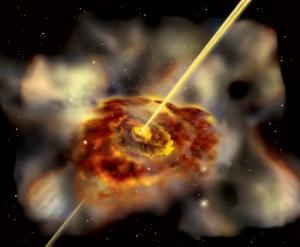 Artist impression of a quasar with a black hole in a brown and yellow disk of gas and dust, which swirls as it is drawn in by the gravitational pull of the black hole, creating friction, heating the gas, and making it shine. Credit: NASA Education and Public Outreach at Sonoma State University - Aurore Simonnet |
The huge black hole is 13 billion lightyears away from Earth at the centre of the quasar. That distance places it near the very edge of the known Universe. lightyears
Quasars are extraordinarily luminous objects. Astronomers think they may be humongous galaxies containing gigantic black holes. SDSS J1148+5251 is such a quasar, which happens to have the most distant black hole at its core.
How much does it weigh? Astronomers have been trying to figure out the mass, or weight, of the black hole inside SDSS J1148+5251. They calculate that it is equal to three billion of our Suns.
The astronomers believe it weighs one quadrillion times the mass of Earth. One quadrillion can be expressed as a one with 15 zeros. That is 1,000,000,000,000,000.
In smaller units of measure, it weighs some 6x1039 kilograms, which could be written out as a 6 followed by 39 zeroes. That would be more than 13x1039 lbs. Now that's big!
|
QUASARS ARE...
|
While the black hole formed eight billion years before the Earth, it appears to be as massive as most black holes known anywhere in the Universe, including those formed much more recently. That surprised astronomers.
A team of astronomers from the United Kingdom and Canada used the United Kingdom Infrared Telescope (UKIRT) atop Mauna Kea in Hawaii to compute the mass of the SDSS J1148+5251 black hole by comparing its infrared light spectrum with closer quasars.
The telescope. The 3.8-metre UKIRT is the largest infrared astronomy telescope. It is near the summit of Mauna Kea at an altitude of 13,759 feet above sea level. The telescope is operated by the Joint Astronomy Centre in Hilo, Hawaii, on behalf of the UK Particle Physics and Astronomy Research Council (PPARC).
UKIRT's Imaging Spectrometer (UIST) — designed at the UK Astronomy Technology Centre (UK ATC) in Edinburgh, Scotland — detects infrared light at wavelengths between 1 and 5 microns with a 1024 x 1024 pixel Indium Antimonide detector array. It can be used for imaging, spectroscopy, integral field spectroscopy, and polarimetry.
The astronomy team used UIST to look at near-infrared light from the quasar SDSS J1148+5251. The expansion of the Universe since that light left the quasar had caused its wavelength to increase, which left little optical light to be seen.
To learn more:
|
| Top of this page | More stories | Deep Space main page | STO cover |